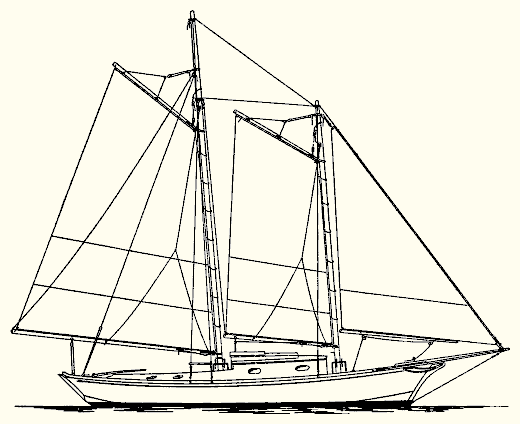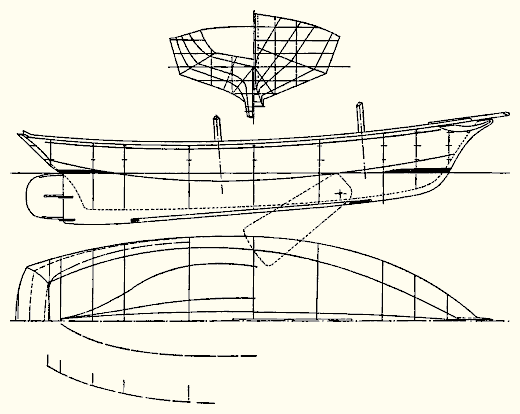
| Capt. Jim Young A 28' 4" V-Bottom Centerboard Schooner By William & John Atkin |
| A V-Bottom Centerboard Schooner | |
There is a great deal to be said for auxiliary cruisers that can be used in shallow water, but there is a dearth of designs for this wholesome type of craft. By wholesome, I refer to able little vessels that have the ability to cruise safely and comfortably offshore or on sheltered waterways in any kind of weather. The plans of the auxiliary, Capt. Jim Young show a V-bottomed, clipper-bowed, gaff-headed schooner of more than passing interest. The little packet, and that describes her, is 28 feet 4 inches in overall length, 21 feet 6 inches on the waterline, 9 feet 7 inches in breadth, and has a draft of 2 feet 10 1/2, inches; this is with the centerboard up. The freeboard at the bow is 3 feet 0 inches, the least freeboard 1 foot 7 inches, and the freeboard at the stern, 2 feet 1 inch. | |

| |
| The sail plan shows what is called a bald-head schooner, that is a schooner without topsails. True there is considerably more height to the mainmast than to the foremast and room for a small working main topsail; the latter, however, is not shown nor intended. The extra length of the main mast can be written down as for "fun." As to the gaff-headed main and foresail, there is much to be said for this type of rig. The mainsail has an area of 165 square feet; the foresail spreads 80 square feet; the jib, 85 square feet. Total area, 320 square feet. So one sees that all three units are small and easy to set, reef, take in, and handle. The standing rigging is all of simple character and should be made of Roebling's galvanized iron (not steel) wire and for the purpose of economy I should use, throughout, galvanized iron blocks. | |

| |
The cabin is a snug little place. It has two bunks, stowage under the forward deck and a 2-foot space for lockers or small counter both sides abaft the bunks. The headroom beneath the companionway slides is 5 feet 2 inches; under the housetop carlins, 4 feet 7 inches. Using a little ingenuity room can be found for the installation of a pump closet if needed. The motor is installed off center to port. I would suggest a single-cylinder Universal Fisherman which develops 8 h.p. turning at 1200 r.p.m. Speed under power will be a .good seven m.p.h. | |

| |
Capt. Jim has a crowned transom stern and molded sections both above and below the chines through the after sections. This molding of the after sections is an important feature of the design, so do not, my Shipmates, cut corners and make these straight sections; this alteration will spoil her appearance and sailing ability. The keel extends in a straight line from stations 4 to 10, sweeping upward in a neat curve to the heel of the rudder post and in a parabolic curve to the stem at the waterline. The keel carries 1,700 pounds of outside lead ballast. Little inside ballast will be required. The rudder is a barndoor affair -- heavy and of large area. This is a necessary feature in the design of a long, straight-keeled hull. It is an old-fashioned type of rudder and rudder post and one which has proved its worth after hundreds of years of use on vessels with long keels. After studying the plans of Capt. Jim my valued friend and client Fr. J. Warren Hutchins of Bridgeport describes the schooner as a "fun" boat. He says it is fun to speculate on the charm of the design; that it would be fun to spend a few years of spare time to build her; that it would be fun to see her launched -- that it would be fun to sail the double-sticker; that it would be fun to own her; and fun to keep her in a shipshape and Bristol fashion. And, sage-like adds, there are all too few "fun" boats. To which I should like to add a reverent amen. | |
| Plans for Capt. Jim Young are $100 MYSTIC SEAPORT MUSEUM SHIPS PLANS STORE https://store.mysticseaport.org/ships-plans/ shipsplanstore@mysticseaport.org
+1 (860) 572 5360 | |
| BACK TO PLAN LIST | |